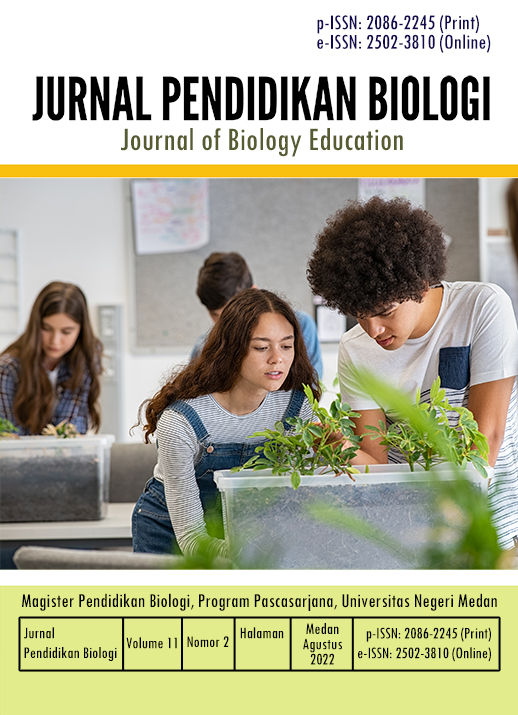Development of Creative Thinking Instruments for Environmental Change
DOI:
https://doi.org/10.24114/jpb.v11i2.26178Keywords:
Creative Thinking, Enviromental Changes, Research & development, Test InstrumentAbstract
One of the skills that must be developed in the 21st century is creative thinking skills. Creative thinking skill that need to be developed because creative thinking skills are the ability to bring up new ideas and interesting thoughts in different situations. There are four aspects of creative thinking skills used in this study, namely: (1) fluency, (2) flexibility, (3) originality, (4) elaboration. The purpose of this research is to develop creative thinking instruments that are used to determine the level of student™s creative thinking abilities. The method used in this research is R and D with the ADDIE model (Analyze, Design, Development, Implementation and Evaluation). The instrument consisted of 11 essay questions which were validated by 2 expert validators and validated on 31 class X high school students empirically who were selected by cluster random sampling and tested on 2 expert validators. In this study, the results obtained 10 valid questions and 1 invalid question with a reliability value of 0.86. Therefore, this creative thinking question instrument can be used as a measuring tool for student creativity. It is hoped that this research can be further developed through implementation by students.References
Almuharomah, F. A., & Mayasari, T. (2018). Pengembangan Instrumen Tes Kemampuan Berpikir Kreatif Siswa SMP terintegrasi Kearifan Lokal. 8.
Branch, R. M. (2009). Instructional Design: The ADDIE Approach. Springer US. https://doi.org/10.1007/978-0-387-09506-6
Fatmawati, A. (2016). Pengembangan Perangkat Pembelajaran Konsep Pencemaran Lingkungan Menggunakan Model Pembelajaran Berdasarkan Masalah Untuk Sma Kelas X. 4, 10.
Istiyono, E., Dwandaru, W. B., & Rahayu, F. (2018). Pengembangan Tes Creative Thinking Skill Fisika SMA (PhysCreTHOTS) Berdasarkan Teori Tes Modern. Cakrawala Pendidikan, (2). 190-200
Istiyono, E., Widihastuti, Supahar, Hamdi, S. (2020). Measuring Creative Thinking Skills of Senior High School Male and Female Students in Physics (CTSP) Using the IRT-based PhysTCreTS. Journal of Turkish Science Education, 17 (4), 578-590.
Joanna Kitto , David Lok & Elizabeth Rudowicz. (1994). Measuring creative thinking: An activitybased approach, Creativity Research Journal, 7:1, 59-69, DOI: 10.1080/10400419409534509
Marwiyah, S., Karmid, Risnita. (2015). Pengembangan Instrumen Penilaian Keterampilan Berpikir Kreatif pada Mata Pelajaran IPA Terpadu Materi Atom, Ion, dan Molekul SMP Islam Al Falah. Edu-Sains Volume 4 No. 1.
Ormrod, Jeanne Ellis. (2009). Psikologi Pendidikan : Membantu Siswa Tumbuh dan Berkembang (terjemahan). Jakarta : Erlangga.
Santi, D. H., Prayitno, B. A., & Muzzazinah, M. (2019). The Problem solving process and creative thinking of students in solving the ecosystem problem. JPBI (Jurnal Pendidikan Biologi Indonesia), 5(3), 537-548. doi: https://doi.org/ 10.22219/jpbi.v5i3.9647
Silver, E. (1997). Fostering creativity through instruction rich in mathematical problem solving and problem posing. Journal Mathematic Education, 29(3), 75-80
Songkram, N. (2015). E“learning system in virtual learning environment to develop creative thinking for learners in higher education. Procedia-Social and Behavioral Sciences, 174, 674“679. doi: https://doi.org/10.1016/j.sbspro.2015.01.60.
Susiningrum, D. (2018). Pengembangan Instrumen Penilaian Kemampuan Berpikir Kreatif Pada Mata Pelajaran Ekonomi Kelas X SMA Hang Tuah 1 Surabaya. 06, 6.
Trilling, B. & Fadel, C. (2009). 21st Century Skills: Learning for Life in Our Times. San Francisco: Jossey-Bass A Wiley Imprint.
Downloads
Published
Issue
Section
License
Copyright (c) 2022 Jurnal Pendidikan Biologi

This work is licensed under a Creative Commons Attribution 4.0 International License.
Copyright
Penyerahan naskah menyiratkan bahwa karya yang diserahkan belum pernah diterbitkan sebelumnya (kecuali sebagai bagian dari tesis, laporan, atau abstrak). Naskah tidak dipertimbangkan untuk publikasi di tempat lain. Penerbitannya telah disetujui oleh semua penulis bersama. Jika dan kapan naskah diterima untuk publikasi, penulis masih memegang hak cipta dan mempertahankan hak penerbitan tanpa batasan. Penulis atau orang lain diperbolehkan untuk melipatgandakan artikel selama tidak untuk tujuan komersial. Untuk penemuan baru, penulis disarankan untuk mengelola patennya sebelum diterbitkan.
Open Access
Jurnal ini berkomitmen untuk membuka akses bebas yang tidak membebankan biaya kepada pembacanya atau lembaga mereka. Pembaca berhak membaca, mengunduh, menyalin, mendistribusikan, mencetak, mencari, atau menautkan ke teks lengkap artikel, selama tidak untuk tujuan komersial. Jenis lisensi adalah CC-BY-4.0.
Disclaimer
Tidak ada tanggung jawab yang dikenakan kepada Penerbit atau oleh editor untuk kesalahan dan/atau kerusakan pada naskah sebagai akibat dari pernyataan pencemaran nama baik atau dugaan pencemaran nama baik, pelanggaran hak kekayaan intelektual atau privasi, atau kewajiban produk, baik akibat kelalaian atau sebaliknya, atau dari penggunaan atau operasi ide, instruksi, prosedur, produk atau metode apa pun yang terkandung dalam materi di dalamnya.

